Corporate Governance and Ethics: Financial Crime and Prevention
VerifiedAdded on 2020/05/28
|7
|2230
|311
Essay
AI Summary
This essay explores the concepts of corporate governance and ethics, focusing on the nature and prevention of financial and white-collar crimes. It begins by defining white-collar crime, its characteristics, and the various types of financial fraud, including corporate crimes and occupational crimes. The essay examines the motivations behind these crimes, such as financial gain and organizational factors, and highlights the challenges in detecting and preventing them. It then delves into an analysis of academic literature, providing examples of reported cases based on the UK regulatory framework, such as the cases of Bernie Madoff and Nick Leeson, and the impact of financial crime on different entities. The essay discusses the role of ethics in preventing financial crimes, emphasizing the importance of clear codes of conduct, ethical leadership, and the identification of root causes. It suggests strategies for detecting and preventing financial crimes, including the implementation of effective systems, employee monitoring, and the use of technology. The essay concludes by summarizing the importance of risk management and internal control mechanisms and the role of ethics in reducing financial crimes.
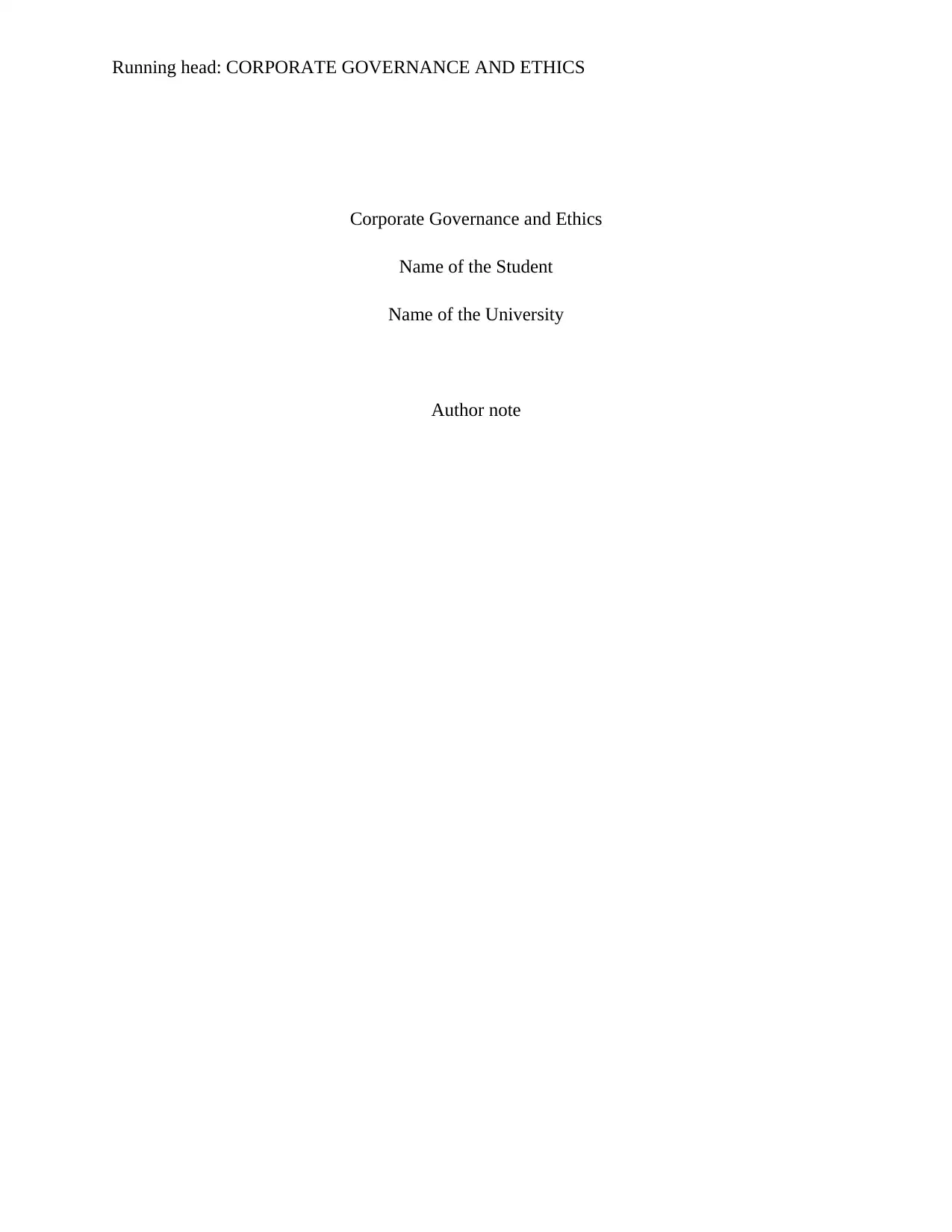
Running head: CORPORATE GOVERNANCE AND ETHICS
Corporate Governance and Ethics
Name of the Student
Name of the University
Author note
Corporate Governance and Ethics
Name of the Student
Name of the University
Author note
Paraphrase This Document
Need a fresh take? Get an instant paraphrase of this document with our AI Paraphraser
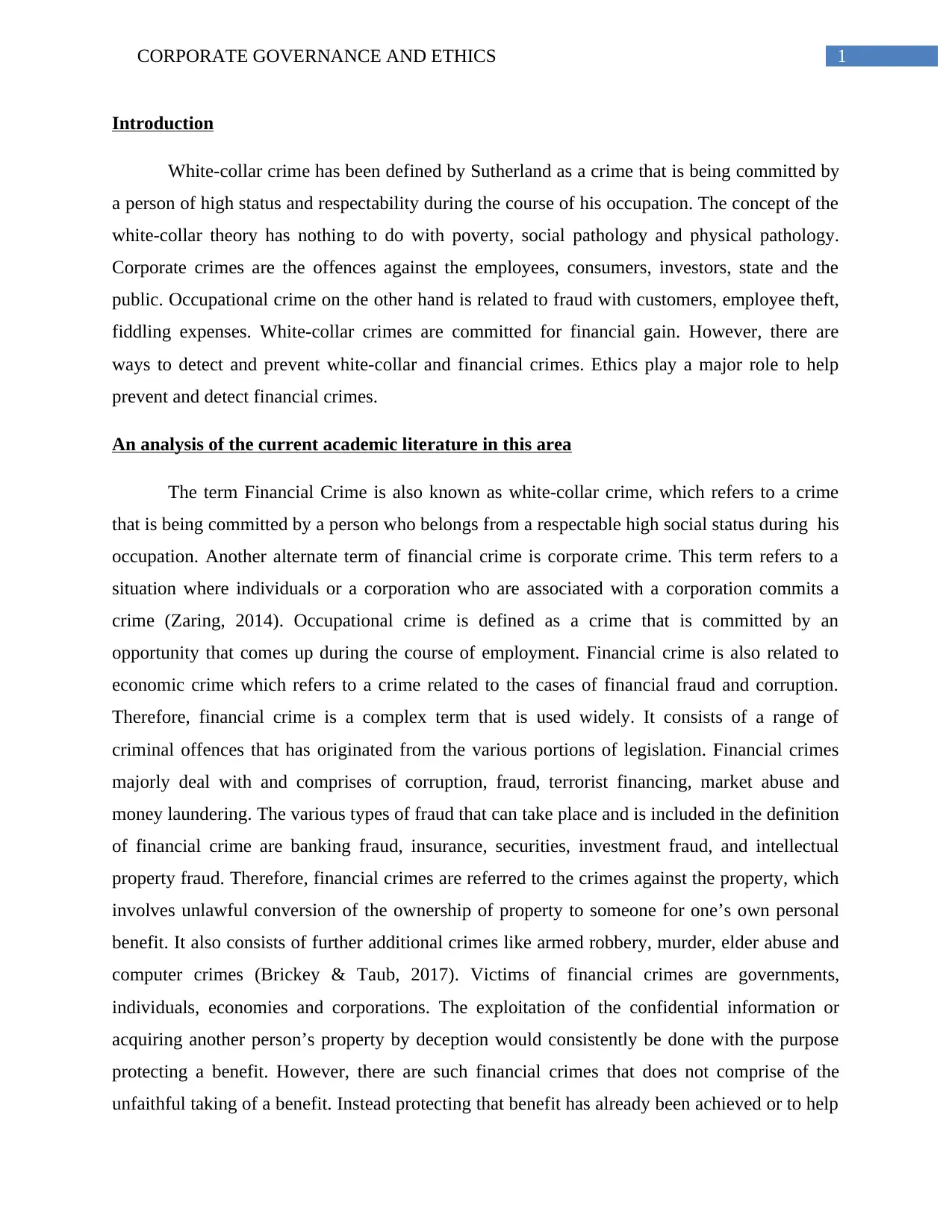
1CORPORATE GOVERNANCE AND ETHICS
Introduction
White-collar crime has been defined by Sutherland as a crime that is being committed by
a person of high status and respectability during the course of his occupation. The concept of the
white-collar theory has nothing to do with poverty, social pathology and physical pathology.
Corporate crimes are the offences against the employees, consumers, investors, state and the
public. Occupational crime on the other hand is related to fraud with customers, employee theft,
fiddling expenses. White-collar crimes are committed for financial gain. However, there are
ways to detect and prevent white-collar and financial crimes. Ethics play a major role to help
prevent and detect financial crimes.
An analysis of the current academic literature in this area
The term Financial Crime is also known as white-collar crime, which refers to a crime
that is being committed by a person who belongs from a respectable high social status during his
occupation. Another alternate term of financial crime is corporate crime. This term refers to a
situation where individuals or a corporation who are associated with a corporation commits a
crime (Zaring, 2014). Occupational crime is defined as a crime that is committed by an
opportunity that comes up during the course of employment. Financial crime is also related to
economic crime which refers to a crime related to the cases of financial fraud and corruption.
Therefore, financial crime is a complex term that is used widely. It consists of a range of
criminal offences that has originated from the various portions of legislation. Financial crimes
majorly deal with and comprises of corruption, fraud, terrorist financing, market abuse and
money laundering. The various types of fraud that can take place and is included in the definition
of financial crime are banking fraud, insurance, securities, investment fraud, and intellectual
property fraud. Therefore, financial crimes are referred to the crimes against the property, which
involves unlawful conversion of the ownership of property to someone for one’s own personal
benefit. It also consists of further additional crimes like armed robbery, murder, elder abuse and
computer crimes (Brickey & Taub, 2017). Victims of financial crimes are governments,
individuals, economies and corporations. The exploitation of the confidential information or
acquiring another person’s property by deception would consistently be done with the purpose
protecting a benefit. However, there are such financial crimes that does not comprise of the
unfaithful taking of a benefit. Instead protecting that benefit has already been achieved or to help
Introduction
White-collar crime has been defined by Sutherland as a crime that is being committed by
a person of high status and respectability during the course of his occupation. The concept of the
white-collar theory has nothing to do with poverty, social pathology and physical pathology.
Corporate crimes are the offences against the employees, consumers, investors, state and the
public. Occupational crime on the other hand is related to fraud with customers, employee theft,
fiddling expenses. White-collar crimes are committed for financial gain. However, there are
ways to detect and prevent white-collar and financial crimes. Ethics play a major role to help
prevent and detect financial crimes.
An analysis of the current academic literature in this area
The term Financial Crime is also known as white-collar crime, which refers to a crime
that is being committed by a person who belongs from a respectable high social status during his
occupation. Another alternate term of financial crime is corporate crime. This term refers to a
situation where individuals or a corporation who are associated with a corporation commits a
crime (Zaring, 2014). Occupational crime is defined as a crime that is committed by an
opportunity that comes up during the course of employment. Financial crime is also related to
economic crime which refers to a crime related to the cases of financial fraud and corruption.
Therefore, financial crime is a complex term that is used widely. It consists of a range of
criminal offences that has originated from the various portions of legislation. Financial crimes
majorly deal with and comprises of corruption, fraud, terrorist financing, market abuse and
money laundering. The various types of fraud that can take place and is included in the definition
of financial crime are banking fraud, insurance, securities, investment fraud, and intellectual
property fraud. Therefore, financial crimes are referred to the crimes against the property, which
involves unlawful conversion of the ownership of property to someone for one’s own personal
benefit. It also consists of further additional crimes like armed robbery, murder, elder abuse and
computer crimes (Brickey & Taub, 2017). Victims of financial crimes are governments,
individuals, economies and corporations. The exploitation of the confidential information or
acquiring another person’s property by deception would consistently be done with the purpose
protecting a benefit. However, there are such financial crimes that does not comprise of the
unfaithful taking of a benefit. Instead protecting that benefit has already been achieved or to help
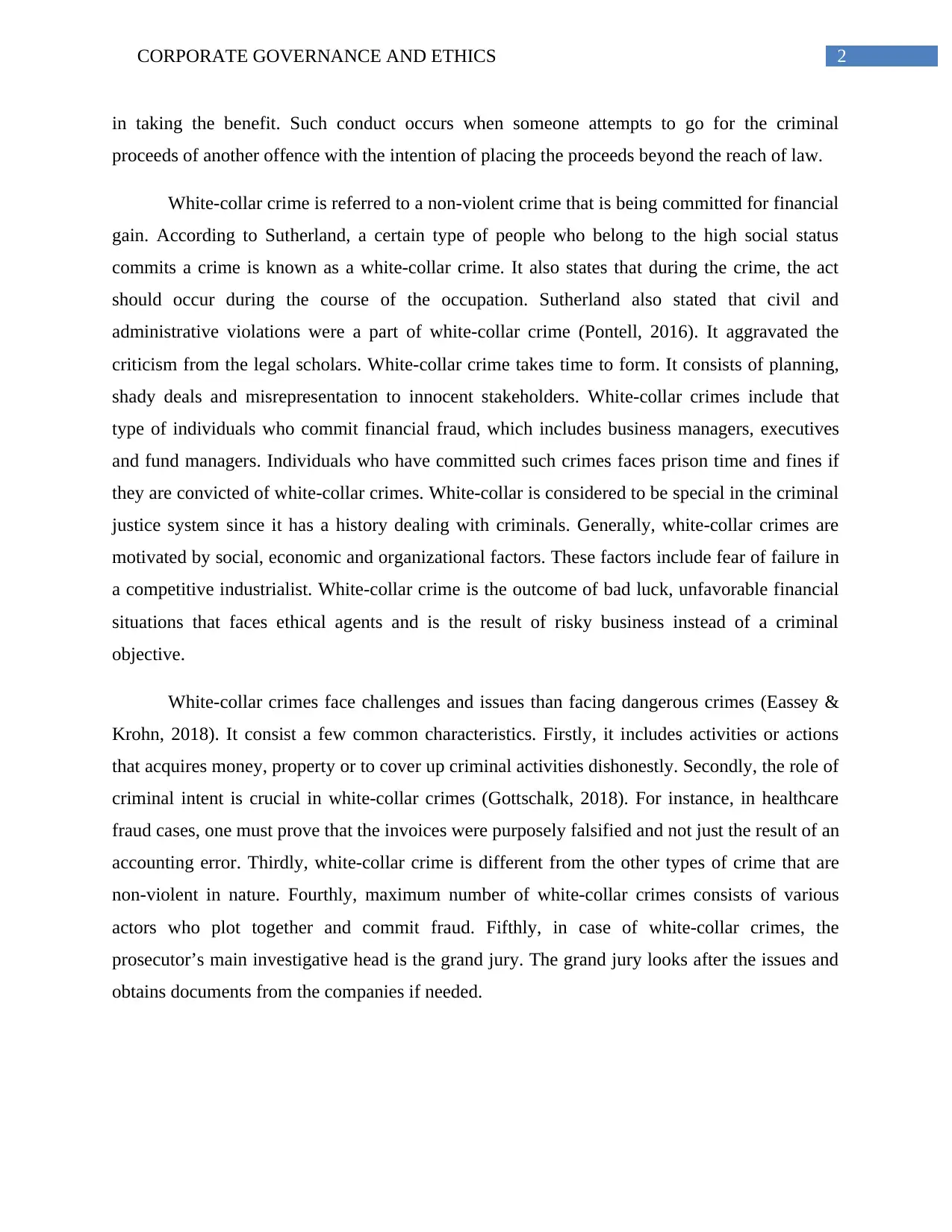
2CORPORATE GOVERNANCE AND ETHICS
in taking the benefit. Such conduct occurs when someone attempts to go for the criminal
proceeds of another offence with the intention of placing the proceeds beyond the reach of law.
White-collar crime is referred to a non-violent crime that is being committed for financial
gain. According to Sutherland, a certain type of people who belong to the high social status
commits a crime is known as a white-collar crime. It also states that during the crime, the act
should occur during the course of the occupation. Sutherland also stated that civil and
administrative violations were a part of white-collar crime (Pontell, 2016). It aggravated the
criticism from the legal scholars. White-collar crime takes time to form. It consists of planning,
shady deals and misrepresentation to innocent stakeholders. White-collar crimes include that
type of individuals who commit financial fraud, which includes business managers, executives
and fund managers. Individuals who have committed such crimes faces prison time and fines if
they are convicted of white-collar crimes. White-collar is considered to be special in the criminal
justice system since it has a history dealing with criminals. Generally, white-collar crimes are
motivated by social, economic and organizational factors. These factors include fear of failure in
a competitive industrialist. White-collar crime is the outcome of bad luck, unfavorable financial
situations that faces ethical agents and is the result of risky business instead of a criminal
objective.
White-collar crimes face challenges and issues than facing dangerous crimes (Eassey &
Krohn, 2018). It consist a few common characteristics. Firstly, it includes activities or actions
that acquires money, property or to cover up criminal activities dishonestly. Secondly, the role of
criminal intent is crucial in white-collar crimes (Gottschalk, 2018). For instance, in healthcare
fraud cases, one must prove that the invoices were purposely falsified and not just the result of an
accounting error. Thirdly, white-collar crime is different from the other types of crime that are
non-violent in nature. Fourthly, maximum number of white-collar crimes consists of various
actors who plot together and commit fraud. Fifthly, in case of white-collar crimes, the
prosecutor’s main investigative head is the grand jury. The grand jury looks after the issues and
obtains documents from the companies if needed.
in taking the benefit. Such conduct occurs when someone attempts to go for the criminal
proceeds of another offence with the intention of placing the proceeds beyond the reach of law.
White-collar crime is referred to a non-violent crime that is being committed for financial
gain. According to Sutherland, a certain type of people who belong to the high social status
commits a crime is known as a white-collar crime. It also states that during the crime, the act
should occur during the course of the occupation. Sutherland also stated that civil and
administrative violations were a part of white-collar crime (Pontell, 2016). It aggravated the
criticism from the legal scholars. White-collar crime takes time to form. It consists of planning,
shady deals and misrepresentation to innocent stakeholders. White-collar crimes include that
type of individuals who commit financial fraud, which includes business managers, executives
and fund managers. Individuals who have committed such crimes faces prison time and fines if
they are convicted of white-collar crimes. White-collar is considered to be special in the criminal
justice system since it has a history dealing with criminals. Generally, white-collar crimes are
motivated by social, economic and organizational factors. These factors include fear of failure in
a competitive industrialist. White-collar crime is the outcome of bad luck, unfavorable financial
situations that faces ethical agents and is the result of risky business instead of a criminal
objective.
White-collar crimes face challenges and issues than facing dangerous crimes (Eassey &
Krohn, 2018). It consist a few common characteristics. Firstly, it includes activities or actions
that acquires money, property or to cover up criminal activities dishonestly. Secondly, the role of
criminal intent is crucial in white-collar crimes (Gottschalk, 2018). For instance, in healthcare
fraud cases, one must prove that the invoices were purposely falsified and not just the result of an
accounting error. Thirdly, white-collar crime is different from the other types of crime that are
non-violent in nature. Fourthly, maximum number of white-collar crimes consists of various
actors who plot together and commit fraud. Fifthly, in case of white-collar crimes, the
prosecutor’s main investigative head is the grand jury. The grand jury looks after the issues and
obtains documents from the companies if needed.
⊘ This is a preview!⊘
Do you want full access?
Subscribe today to unlock all pages.

Trusted by 1+ million students worldwide
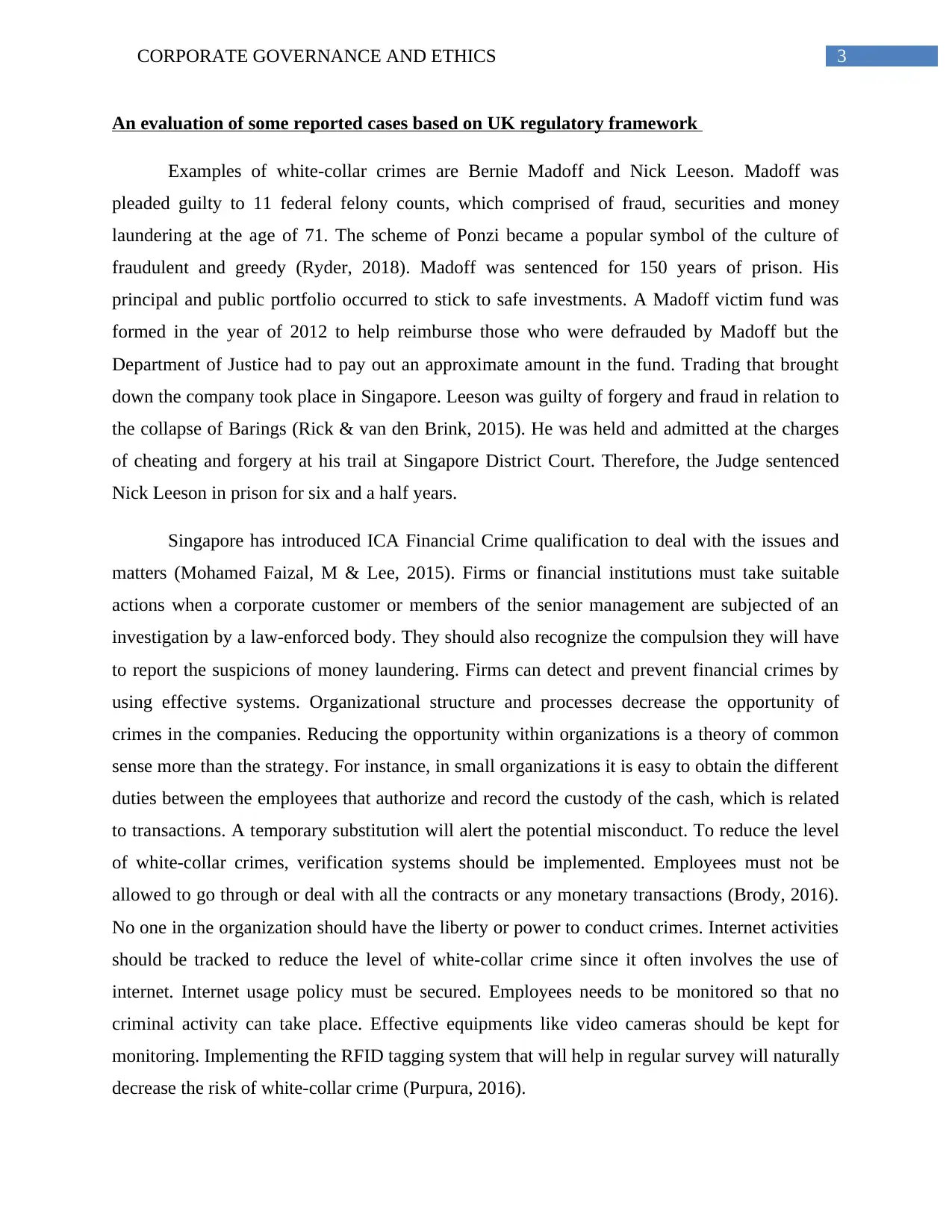
3CORPORATE GOVERNANCE AND ETHICS
An evaluation of some reported cases based on UK regulatory framework
Examples of white-collar crimes are Bernie Madoff and Nick Leeson. Madoff was
pleaded guilty to 11 federal felony counts, which comprised of fraud, securities and money
laundering at the age of 71. The scheme of Ponzi became a popular symbol of the culture of
fraudulent and greedy (Ryder, 2018). Madoff was sentenced for 150 years of prison. His
principal and public portfolio occurred to stick to safe investments. A Madoff victim fund was
formed in the year of 2012 to help reimburse those who were defrauded by Madoff but the
Department of Justice had to pay out an approximate amount in the fund. Trading that brought
down the company took place in Singapore. Leeson was guilty of forgery and fraud in relation to
the collapse of Barings (Rick & van den Brink, 2015). He was held and admitted at the charges
of cheating and forgery at his trail at Singapore District Court. Therefore, the Judge sentenced
Nick Leeson in prison for six and a half years.
Singapore has introduced ICA Financial Crime qualification to deal with the issues and
matters (Mohamed Faizal, M & Lee, 2015). Firms or financial institutions must take suitable
actions when a corporate customer or members of the senior management are subjected of an
investigation by a law-enforced body. They should also recognize the compulsion they will have
to report the suspicions of money laundering. Firms can detect and prevent financial crimes by
using effective systems. Organizational structure and processes decrease the opportunity of
crimes in the companies. Reducing the opportunity within organizations is a theory of common
sense more than the strategy. For instance, in small organizations it is easy to obtain the different
duties between the employees that authorize and record the custody of the cash, which is related
to transactions. A temporary substitution will alert the potential misconduct. To reduce the level
of white-collar crimes, verification systems should be implemented. Employees must not be
allowed to go through or deal with all the contracts or any monetary transactions (Brody, 2016).
No one in the organization should have the liberty or power to conduct crimes. Internet activities
should be tracked to reduce the level of white-collar crime since it often involves the use of
internet. Internet usage policy must be secured. Employees needs to be monitored so that no
criminal activity can take place. Effective equipments like video cameras should be kept for
monitoring. Implementing the RFID tagging system that will help in regular survey will naturally
decrease the risk of white-collar crime (Purpura, 2016).
An evaluation of some reported cases based on UK regulatory framework
Examples of white-collar crimes are Bernie Madoff and Nick Leeson. Madoff was
pleaded guilty to 11 federal felony counts, which comprised of fraud, securities and money
laundering at the age of 71. The scheme of Ponzi became a popular symbol of the culture of
fraudulent and greedy (Ryder, 2018). Madoff was sentenced for 150 years of prison. His
principal and public portfolio occurred to stick to safe investments. A Madoff victim fund was
formed in the year of 2012 to help reimburse those who were defrauded by Madoff but the
Department of Justice had to pay out an approximate amount in the fund. Trading that brought
down the company took place in Singapore. Leeson was guilty of forgery and fraud in relation to
the collapse of Barings (Rick & van den Brink, 2015). He was held and admitted at the charges
of cheating and forgery at his trail at Singapore District Court. Therefore, the Judge sentenced
Nick Leeson in prison for six and a half years.
Singapore has introduced ICA Financial Crime qualification to deal with the issues and
matters (Mohamed Faizal, M & Lee, 2015). Firms or financial institutions must take suitable
actions when a corporate customer or members of the senior management are subjected of an
investigation by a law-enforced body. They should also recognize the compulsion they will have
to report the suspicions of money laundering. Firms can detect and prevent financial crimes by
using effective systems. Organizational structure and processes decrease the opportunity of
crimes in the companies. Reducing the opportunity within organizations is a theory of common
sense more than the strategy. For instance, in small organizations it is easy to obtain the different
duties between the employees that authorize and record the custody of the cash, which is related
to transactions. A temporary substitution will alert the potential misconduct. To reduce the level
of white-collar crimes, verification systems should be implemented. Employees must not be
allowed to go through or deal with all the contracts or any monetary transactions (Brody, 2016).
No one in the organization should have the liberty or power to conduct crimes. Internet activities
should be tracked to reduce the level of white-collar crime since it often involves the use of
internet. Internet usage policy must be secured. Employees needs to be monitored so that no
criminal activity can take place. Effective equipments like video cameras should be kept for
monitoring. Implementing the RFID tagging system that will help in regular survey will naturally
decrease the risk of white-collar crime (Purpura, 2016).
Paraphrase This Document
Need a fresh take? Get an instant paraphrase of this document with our AI Paraphraser
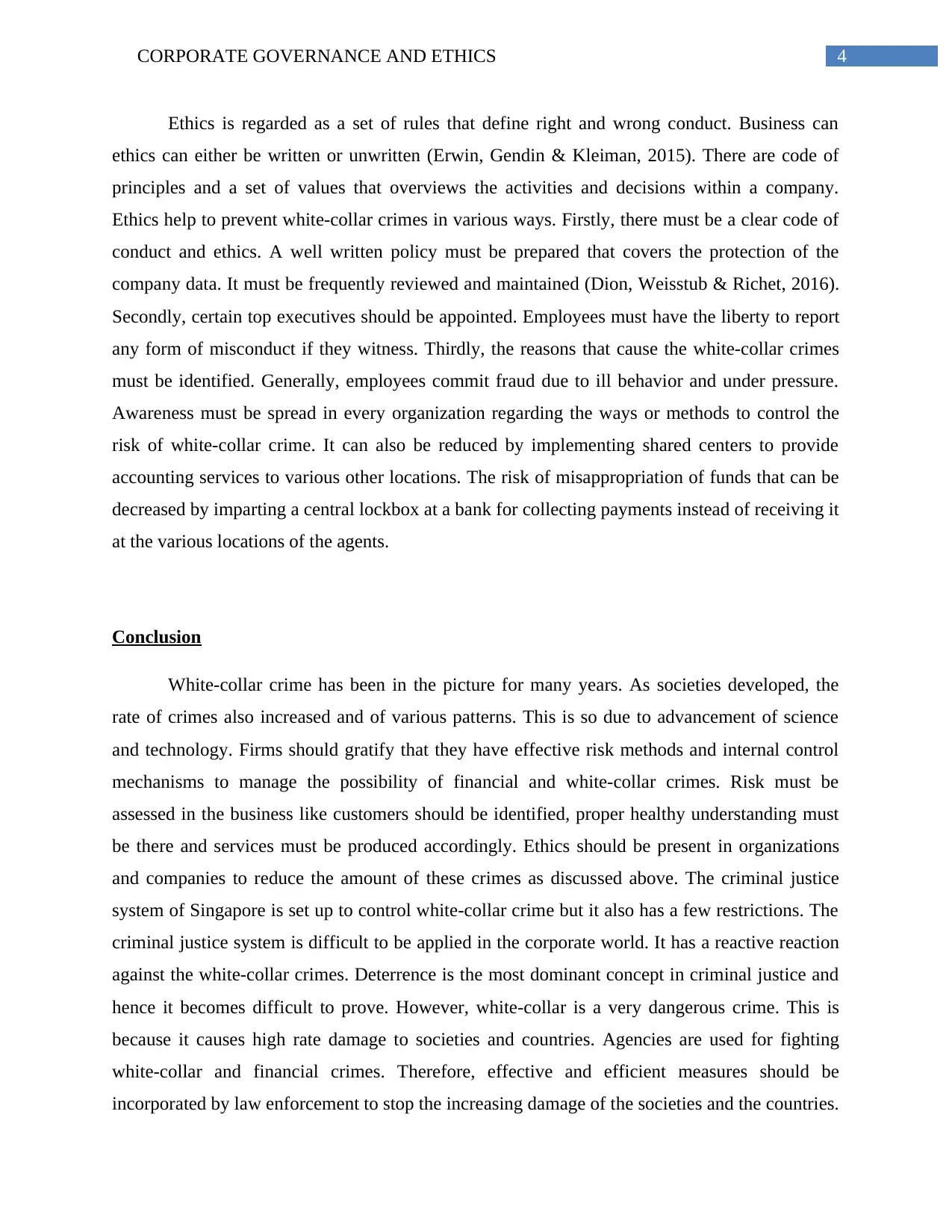
4CORPORATE GOVERNANCE AND ETHICS
Ethics is regarded as a set of rules that define right and wrong conduct. Business can
ethics can either be written or unwritten (Erwin, Gendin & Kleiman, 2015). There are code of
principles and a set of values that overviews the activities and decisions within a company.
Ethics help to prevent white-collar crimes in various ways. Firstly, there must be a clear code of
conduct and ethics. A well written policy must be prepared that covers the protection of the
company data. It must be frequently reviewed and maintained (Dion, Weisstub & Richet, 2016).
Secondly, certain top executives should be appointed. Employees must have the liberty to report
any form of misconduct if they witness. Thirdly, the reasons that cause the white-collar crimes
must be identified. Generally, employees commit fraud due to ill behavior and under pressure.
Awareness must be spread in every organization regarding the ways or methods to control the
risk of white-collar crime. It can also be reduced by implementing shared centers to provide
accounting services to various other locations. The risk of misappropriation of funds that can be
decreased by imparting a central lockbox at a bank for collecting payments instead of receiving it
at the various locations of the agents.
Conclusion
White-collar crime has been in the picture for many years. As societies developed, the
rate of crimes also increased and of various patterns. This is so due to advancement of science
and technology. Firms should gratify that they have effective risk methods and internal control
mechanisms to manage the possibility of financial and white-collar crimes. Risk must be
assessed in the business like customers should be identified, proper healthy understanding must
be there and services must be produced accordingly. Ethics should be present in organizations
and companies to reduce the amount of these crimes as discussed above. The criminal justice
system of Singapore is set up to control white-collar crime but it also has a few restrictions. The
criminal justice system is difficult to be applied in the corporate world. It has a reactive reaction
against the white-collar crimes. Deterrence is the most dominant concept in criminal justice and
hence it becomes difficult to prove. However, white-collar is a very dangerous crime. This is
because it causes high rate damage to societies and countries. Agencies are used for fighting
white-collar and financial crimes. Therefore, effective and efficient measures should be
incorporated by law enforcement to stop the increasing damage of the societies and the countries.
Ethics is regarded as a set of rules that define right and wrong conduct. Business can
ethics can either be written or unwritten (Erwin, Gendin & Kleiman, 2015). There are code of
principles and a set of values that overviews the activities and decisions within a company.
Ethics help to prevent white-collar crimes in various ways. Firstly, there must be a clear code of
conduct and ethics. A well written policy must be prepared that covers the protection of the
company data. It must be frequently reviewed and maintained (Dion, Weisstub & Richet, 2016).
Secondly, certain top executives should be appointed. Employees must have the liberty to report
any form of misconduct if they witness. Thirdly, the reasons that cause the white-collar crimes
must be identified. Generally, employees commit fraud due to ill behavior and under pressure.
Awareness must be spread in every organization regarding the ways or methods to control the
risk of white-collar crime. It can also be reduced by implementing shared centers to provide
accounting services to various other locations. The risk of misappropriation of funds that can be
decreased by imparting a central lockbox at a bank for collecting payments instead of receiving it
at the various locations of the agents.
Conclusion
White-collar crime has been in the picture for many years. As societies developed, the
rate of crimes also increased and of various patterns. This is so due to advancement of science
and technology. Firms should gratify that they have effective risk methods and internal control
mechanisms to manage the possibility of financial and white-collar crimes. Risk must be
assessed in the business like customers should be identified, proper healthy understanding must
be there and services must be produced accordingly. Ethics should be present in organizations
and companies to reduce the amount of these crimes as discussed above. The criminal justice
system of Singapore is set up to control white-collar crime but it also has a few restrictions. The
criminal justice system is difficult to be applied in the corporate world. It has a reactive reaction
against the white-collar crimes. Deterrence is the most dominant concept in criminal justice and
hence it becomes difficult to prove. However, white-collar is a very dangerous crime. This is
because it causes high rate damage to societies and countries. Agencies are used for fighting
white-collar and financial crimes. Therefore, effective and efficient measures should be
incorporated by law enforcement to stop the increasing damage of the societies and the countries.
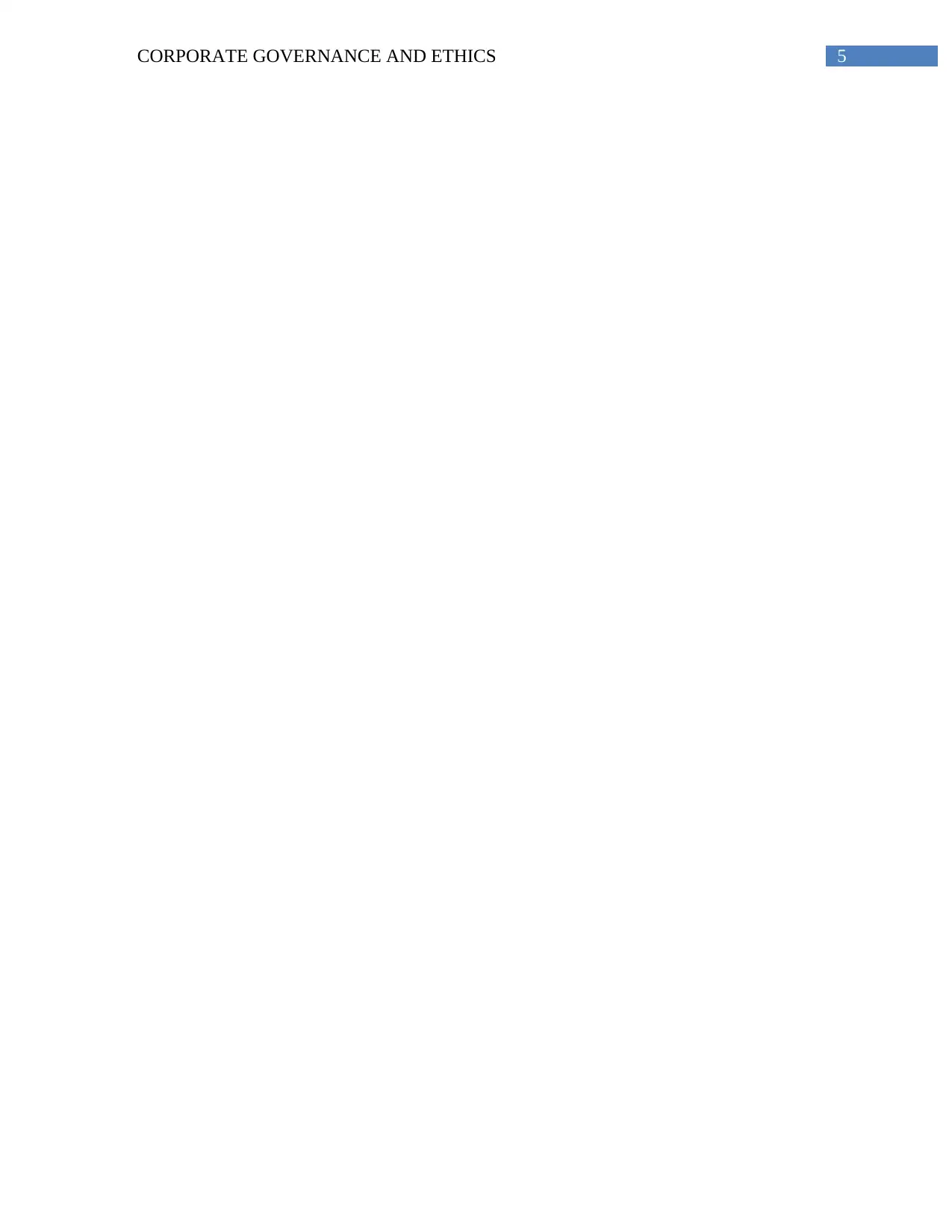
5CORPORATE GOVERNANCE AND ETHICS
⊘ This is a preview!⊘
Do you want full access?
Subscribe today to unlock all pages.

Trusted by 1+ million students worldwide
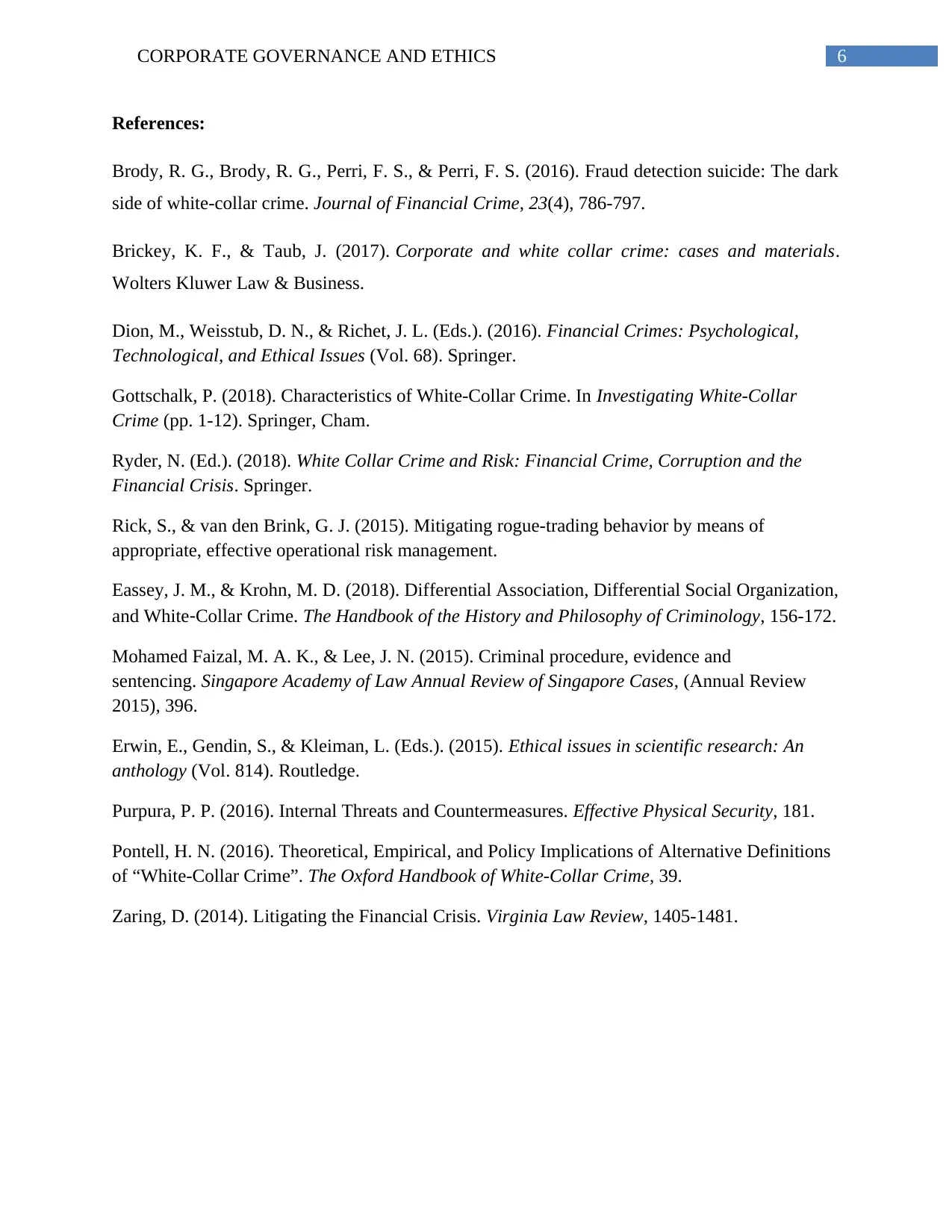
6CORPORATE GOVERNANCE AND ETHICS
References:
Brody, R. G., Brody, R. G., Perri, F. S., & Perri, F. S. (2016). Fraud detection suicide: The dark
side of white-collar crime. Journal of Financial Crime, 23(4), 786-797.
Brickey, K. F., & Taub, J. (2017). Corporate and white collar crime: cases and materials.
Wolters Kluwer Law & Business.
Dion, M., Weisstub, D. N., & Richet, J. L. (Eds.). (2016). Financial Crimes: Psychological,
Technological, and Ethical Issues (Vol. 68). Springer.
Gottschalk, P. (2018). Characteristics of White-Collar Crime. In Investigating White-Collar
Crime (pp. 1-12). Springer, Cham.
Ryder, N. (Ed.). (2018). White Collar Crime and Risk: Financial Crime, Corruption and the
Financial Crisis. Springer.
Rick, S., & van den Brink, G. J. (2015). Mitigating rogue-trading behavior by means of
appropriate, effective operational risk management.
Eassey, J. M., & Krohn, M. D. (2018). Differential Association, Differential Social Organization,
and White‐Collar Crime. The Handbook of the History and Philosophy of Criminology, 156-172.
Mohamed Faizal, M. A. K., & Lee, J. N. (2015). Criminal procedure, evidence and
sentencing. Singapore Academy of Law Annual Review of Singapore Cases, (Annual Review
2015), 396.
Erwin, E., Gendin, S., & Kleiman, L. (Eds.). (2015). Ethical issues in scientific research: An
anthology (Vol. 814). Routledge.
Purpura, P. P. (2016). Internal Threats and Countermeasures. Effective Physical Security, 181.
Pontell, H. N. (2016). Theoretical, Empirical, and Policy Implications of Alternative Definitions
of “White-Collar Crime”. The Oxford Handbook of White-Collar Crime, 39.
Zaring, D. (2014). Litigating the Financial Crisis. Virginia Law Review, 1405-1481.
References:
Brody, R. G., Brody, R. G., Perri, F. S., & Perri, F. S. (2016). Fraud detection suicide: The dark
side of white-collar crime. Journal of Financial Crime, 23(4), 786-797.
Brickey, K. F., & Taub, J. (2017). Corporate and white collar crime: cases and materials.
Wolters Kluwer Law & Business.
Dion, M., Weisstub, D. N., & Richet, J. L. (Eds.). (2016). Financial Crimes: Psychological,
Technological, and Ethical Issues (Vol. 68). Springer.
Gottschalk, P. (2018). Characteristics of White-Collar Crime. In Investigating White-Collar
Crime (pp. 1-12). Springer, Cham.
Ryder, N. (Ed.). (2018). White Collar Crime and Risk: Financial Crime, Corruption and the
Financial Crisis. Springer.
Rick, S., & van den Brink, G. J. (2015). Mitigating rogue-trading behavior by means of
appropriate, effective operational risk management.
Eassey, J. M., & Krohn, M. D. (2018). Differential Association, Differential Social Organization,
and White‐Collar Crime. The Handbook of the History and Philosophy of Criminology, 156-172.
Mohamed Faizal, M. A. K., & Lee, J. N. (2015). Criminal procedure, evidence and
sentencing. Singapore Academy of Law Annual Review of Singapore Cases, (Annual Review
2015), 396.
Erwin, E., Gendin, S., & Kleiman, L. (Eds.). (2015). Ethical issues in scientific research: An
anthology (Vol. 814). Routledge.
Purpura, P. P. (2016). Internal Threats and Countermeasures. Effective Physical Security, 181.
Pontell, H. N. (2016). Theoretical, Empirical, and Policy Implications of Alternative Definitions
of “White-Collar Crime”. The Oxford Handbook of White-Collar Crime, 39.
Zaring, D. (2014). Litigating the Financial Crisis. Virginia Law Review, 1405-1481.
1 out of 7
Related Documents
Your All-in-One AI-Powered Toolkit for Academic Success.
+13062052269
info@desklib.com
Available 24*7 on WhatsApp / Email
![[object Object]](/_next/static/media/star-bottom.7253800d.svg)
Unlock your academic potential
Copyright © 2020–2025 A2Z Services. All Rights Reserved. Developed and managed by ZUCOL.





